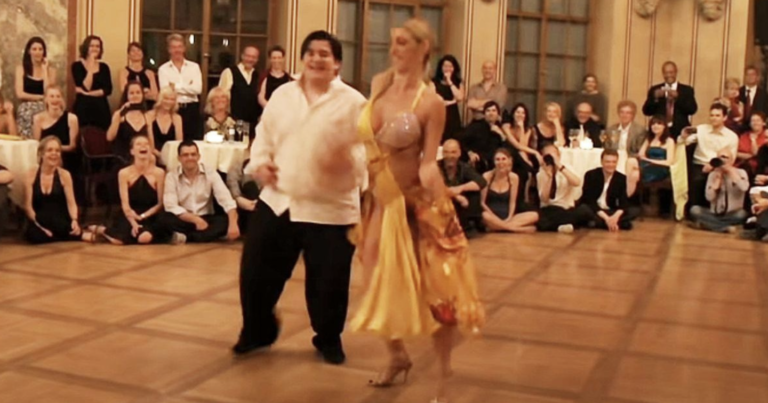The Vienna Grand Palais glittered under chandeliers that night, alive with the hum of conversation and the faint perfume of anticipation. The TANGOAMADEUS festival had returned after a five-year hiatus—an event revered in the world of dance, where only the finest were invited to perform. Critics, influencers, and ballroom legends filled the velvet seats, murmuring with champagne in hand.
But the talk of the evening wasn’t about the celebrity judges or the expensive costumes. It was about the unknown performer listed last on the program:
“Alejandro Cruz — Solo Performance: El Último Tango del Corazón.”
No one knew who he was.
The name had no digital footprint—no interviews, no videos, no social media. Just a short biography in the brochure:
“A dancer who believes that passion transcends form.”
It was vague, even pretentious. And when Alejandro finally appeared from the wings, the audience’s reaction was immediate.
The First Step
He was not what they expected.
A large man—broad-shouldered, with the physique of someone who had labored more than trained. His black shirt was simple, unadorned. He looked almost out of place amid the sleek, athletic dancers who had dazzled before him. Laughter rippled softly through the hall. Even one of the judges, famed choreographer Evelyn Marche, raised an eyebrow.
But Alejandro didn’t seem to notice.
He stood utterly still, eyes closed, as the first melancholy notes of the bandoneón filled the air.
And then he moved.
Not like anyone expected.
Each motion was deliberate, flowing with impossible grace. His steps defied his frame—sharp yet fluid, his turns breathtakingly precise. The crowd’s laughter evaporated. Every pivot, every spin, was imbued with such raw intensity that the room seemed to shrink around him.
When he lifted his arms and twirled into a sweeping cross-step, the audience gasped aloud.
He wasn’t just dancing.
He was telling a story.
The Rhythm of Memory
The music grew faster, darker. Alejandro’s movements grew wilder, desperate. The spotlight cast deep shadows across his face, revealing tears cutting through his makeup. He clutched his chest, staggering backward as though fighting an invisible partner.
Every emotion—love, loss, rage—unfolded before them.
Even the cynical critics were riveted. Evelyn leaned forward, whispering, “He’s… transcendent.”
But as the crescendo built, something strange began to happen.
The lights above flickered. The sound system emitted a low, unnatural hum beneath the music. The stage itself seemed to tremble.
And when Alejandro turned sharply into his final sequence, the floor mirrored him—a perfect reflection appearing beneath the glassy surface.
Only the reflection didn’t move in sync.
It was a beat behind.
The Ghost in the Floor
At first, the audience thought it was a trick of the lighting—a planned illusion. But as Alejandro danced, his reflection’s delay grew longer. The mirrored version’s movements became more frantic, distorted.
Then came the first scream.
The reflection looked up.
Its face wasn’t Alejandro’s. It was older. Haggard. Eyes hollow, as if drained of light.
The dancer above froze.
Gasps echoed through the hall. The lights dimmed to crimson.
Alejandro stared down, trembling, and whispered one word.
“Lucia.”
And in that instant, everything changed.
The Secret of the Stage
Backstage chaos erupted. Technicians rushed to shut down the lights, but none of the controls responded. The reflection—the apparition—rose slowly from the mirrored floor, forming a figure beside him: a woman in a flowing red tango dress, her face pale as moonlight.
The audience fell into stunned silence.
“Ladies and gentlemen,” a voice whispered over the speakers—soft, distorted, undeniably female.
“You promised me one last dance.”
The apparition extended her hand.
Alejandro’s expression crumpled.
He took it.
The Dance of the Dead
Music filled the air again, but now it was warped, echoing through unseen depths. Together, Alejandro and the phantom moved as one—every step synchronized in agony and beauty.
The crowd could not look away.
It was hypnotic, horrifying, divine.
Each motion seemed to tear at reality itself—the air shimmered around them like heat on asphalt. The audience began to feel it: an ache in their chests, as if their own memories were being pulled from them.
Evelyn whispered, “Stop the performance!”
But the stage technicians were frozen.
Then, with a flourish that seemed to tear through the music, Alejandro spun the ghostly woman into a final dip—her dress dissolving into smoke, her eyes closing in peace.
A thunderous silence followed.
Then—blackout.
The Aftermath
When the lights returned, Alejandro was gone.
All that remained was his guitar and a single rose resting center stage.
Security searched the building. No trace. No exit footage. No witnesses.
The judges sat in disbelief. The audience—shaken, tear-streaked—applauded hesitantly, unsure if what they had witnessed was performance or possession.
Evelyn rose, whispering, “Lucia… I remember that name.”
Her assistant blinked. “What do you mean?”
She pointed to an old TANGOAMADEUS poster hanging backstage, half-buried behind equipment.
“Alejandro and Lucia Cruz — The Dance of Eternal Fire, 1992.”
Below the headline, smaller text read:
Tragic accident claims life of rising star Lucia Cruz during performance.
Partner Alejandro Cruz retires from dance, presumed dead two years later.
The Legend Lives On
The footage of the 2012 performance was never broadcast.
But clips leaked.
In every version, the audience appears frozen mid-clap—eyes glazed, unmoving—as Alejandro and the ghostly Lucia blur into one form before vanishing.
Experts called it doctored. The organizers denied everything. Yet those who were there—every single attendee—reported the same sensation: a soft whisper in their ear during the final bow.
“Dance with who you’ve lost, and you’ll never stop dancing.”
Years later, TANGOAMADEUS canceled its festival permanently, citing “unexplained structural instability” in the Palais stage.
But sometimes, on quiet nights, locals say they still hear faint bandoneón music echoing through the empty ballroom—two dancers’ footsteps, weaving endlessly through the dark.
